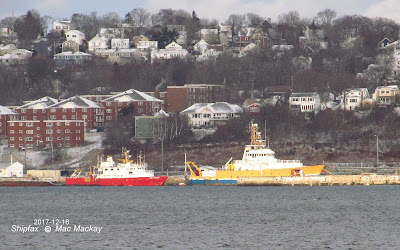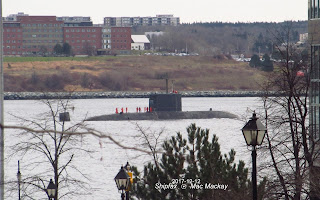December 26, Boxing Day, is a holiday for most people in Halifax, and
a day to clean up after Christmas. Shipping began to move again after a
fierce windstorm that left many without power. Gusts up to 100 kph were
recorded in some parts of western Nova Scotia and ferry services to New
Brunswick and Newfoundland were disrupted again as they have been for
several days. Temperatures in Halifax rocketed up to +7C Christmas Day
as heavy rain accompanied the winds, and dropped again to -7C for Boxing
Day.
One can only imagine conditions at sea, as several ships
waited out the storm offshore or were delayed in arriving. There was of
course the usual pre-Christmas rush as several ships finished up their
work and got off to sea before the holiday - and the weather.
December 21
Irving Oil Woodside played host to the tanker
British Sailor
December 19 to 21. As usual with Irving Oil imports the ship arrived
from Amsterdam via the Ijmuiden sea lock and sailed for Saint John.
From
this angle, the background is the now denuded Imperial Oil refinery
site, but the ship is berthed at Irving Oil's Woodside terminal.
BP,
unlike many other oil majors, still operates a fleet of tankers, but
they are no longer the elegant and distinctive vessels of the 1950s and
60s. Although nominally British, (it is flagged in the Isle of Man) the
ship was mass produced in 2016 by Hyundai Mipo in Ulsan, and is of the
Mid-Range size of 30,948 grt, 45,999 dwt. The larger gross tonnage is
apparently due to an extra accommodation deck in the superstructure. See
the following
December 22
Also beating the rush was the tanker
Beryl which arrived from Houston with refined product for Imperial Oil.
A
more typical Mid-Range tanker, it measures 29,766 grt 49,990 dwt and
was built in 2015 by SPP Shipbuilding Co of Incheon. It sailed early
Christmas morning for Come-by-Chance, NL.
December 22
A heavy lift cargo arrived at pier 31 on December aboard the Spliethoff "F" class ship
Floragracht.
By the time I caught up with her, the green object in the foreground had been unloaded and the ship was
loading
what looked like reinforcing steel, using Logistec's mobile crane. The
ship's last port was Baltimore, but the cargo could have originated
almost anywhere, since these ships trade world wide.
On
December 23, the ship was re-stowing tween decks, using its own gear,
which consists of three 80 tonne cranes.It sailed later in the day
giving Aberdeen. Scotland as its destination.
The 8620 grt, 12,178
dwt ship was built in 2011 by Jiangsu Changbo Shipyard in Jingjiang
China, one of six multi-purpose ships of the class in the Spliethoff
fleet.
December 23
The impressive autocarrier
Grande Baltimora
made its second appearance in Halifax in as many months. Owned by the
Grimaldi Group it was delivering cars to Autoport (likely Fiat
products). Unusually however, it then moved to Fairview Cove to unload
more RoRo cargo.
Since
the Grimaldi Group also owns Atlantic Container Line, it is possible
that the ship was carrying some ACL cargo. After that the ship went to
anchor to wait out a big blow, and sailed early December 24.
Built
by Jinling Shipyard in Nanjing, the ship was delivered in July of this
year, and measures 62,134 grt, 18,447 dwt and has a capacity of 6700
autos. It also has a 150 tonne stern ramp for other RoRo cargoes.
December 24
The tanker
Alhena
arrived from New Orleans for Imperial Oil, but did not spend long at
the dock. It moved to anchor in Bedford Basin early on Christmas
morning.
A
slight variation in the usual run of handy size tankers, this one was
built in 2012 by Guangzhou International in China. Tonnages of 30,240
grt, 52,420 are on the high side for Mid-Range. The Bahamas flag ship is
managed by Super-Echo Tankers Management Inc for the obscurely named
Nightingale Seacarriers Ltd.
Meanwhile three container
ships left port, all delayed by high winds the night before. Since all
three were scheduled for about the same time, I chose to go after
Dalian Expres,
one of the few HAPAG-Lloyd ships on the THE Alliance services, which is
almost exclusively carried out in Halifax by Yang Ming and K-Line.
ships.
Dalian Express makes the dogleg turn in the Narrows, as the cable ship IT Intrepid lies at its winter base at Pier 9A.
The former
Hamburg Express
to 2011, is a 7506 TEU vessel of 88,493 grt, 100,006 dwt, built in 2001
by Hyundai, Ulsan, and is about the largest size ship able to transit
the two harbour bridges to reach the Ceres terminal in Fairview Cove.
CMA CGM Ivanhoe and
Maersk Patras sailed from Halterm at about the same time
December 25
After
an almost springlike December 24, high winds picked up again Christmas
morning, bringing rainy and squally conditions off and on. The tanker
Alhena made for Bedford Basin anchorage, since its berth at Imperial Oil was exposed to the brunt of the winds.
Alhena in blustery conditions with the cargo ship
Thorco Logos in the background, joined
Fagelgracht,
another of the Spleithoff "F" class ships, that arrived the night
before from Liverpool. UK. There was an afternoon sunny break but it
could not cut through the salt laden spume blowing in from sea.
Fagelgracht
has some containers on deck forward, but otherwise appears light. The
ship may be the first of the winter callers for Spliethoff. The company
has a regular schedule to Great Lakes ports such as Cleveland and
Chicago in season, but with the St.Lawrence Seaway closing December 31,
this ship would not have time to make those calls and exit before
shutdown. Last winter the ships called regularly in Halifax until the
Seaway re-opened in spring.
December 26
With conditions returning to fairly calm, it was a very different picture in Bedford Basin.
Thorco Logos,
with its holds fitted for cable transport, has been idle in the Basin
since mid- November (aside from a brief stores replenishment visit to
Pier 9C December 12 to 14) .
Alhena does not appear to have dragged much, and is ready to take bunkers later in the day from
Algoma Dartmouth.
Aboard
Fagelgracht a crew member attends to some maintenance. He is just visible in orange trousers and yellow coat atop the open hatch.
Among the arrivals today is the impressive research ship
Fugro Discovery. It has been hired by Fisheries and Oceans for the Newfoundland Oceanography Monitoring Program normally carried out by CCGS
Hudson.
That ship's interrupted refit, now due for completion sometime in the
spring of 2018 (a year late) has resulted in millions of dollars spent
on chartered ships to do its work.
FugroDiscovery's charter alone will be in excess of $880,000 (not including taxes).
Built by the Marynaki naval shipyard in Gdynia, Poland and completed by Mykleburst MV in Gurksen, Norway in 1997, as
Tromso the
ship served out a ten year charter to the Norwegian Coast Guard as an
offshore patrol vessel. It was armed with a 40mm/L60 Bofors cannon and
carried out EEZ patrols, fisheries inspections, search and rescue
missions and pollution control.
In March 2007 it ended the charter
and was sold to the Dutch survey company Fugro and converted to a
research vessel, flying the Panama flag. It was fitted with a 16 tonne
capacity A-frame and other gear to support a ROV. It has accommodation
for 24 persons.
Last year the ship assisted in the unsuccessful search for Malaysian Airlines flight MH370 in the southern Indian Ocean.
This
year Fugro applied for a coasting license to survey the Flemish Pass,
Orphan Basin and Carson Canyon off Newfoundland for Nalcor Energy. So
far I have been unable to find a record that the license was granted.
The application covered the period from mid-August to December 31.
In the background the idle CCGS Hudson lies alongside the Bedford Institute, its refit not yet complete. Also alongside is the decommissioned survey vessel Matthew which has been for sale off an on for several years, without any takers.
Also at the Bedford Institute, two new long range SAR lifeboats,
Baie de Plaisance and
Pennant Bay are undergoing trials and training before entering service in the spring.
Baie de Plaisance will be stationed in Cap-aux-Meules, Magdalen Islands, replacing
Cap-aux-Meules and
Pennant Bay in Sambro, NS, replacing
Sambro. They are part of a large order for twenty craft replacing boats on both coasts.
.





















































